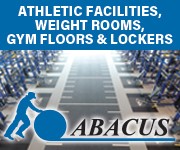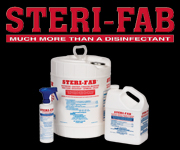Flooring plays a key role in achieving all of this, as it has a big influence on the overall functionality, sustainability, and aesthetics of the space. Therefore, it comes as no surprise that all contemporary trends in sport and fitness flooring focus on greater flexibility, increased safety and comfort, smaller carbon footprint, higher aesthetic appeal, and enhanced personality.
If you’re designing a new facility or renovating an existing one, you’ll probably want to keep pace with the popular tendencies. Here are some of the most prominent sports flooring trends to consider in 2019.
The prevailing tendency in modern gyms, fitness centers, and health clubs is towards less equipment and more functional training areas. This transformation requires versatile, durable flooring that is able to accommodate a variety of different activities:
Multi-purpose use-Contemporary sports facilities need versatile flooring that allows them to offer a diverse range of activities- from basketball games and racquetball practices to track meets and dancing events. The sports surface has to be safe, resilient, and high-performing and must meet the required standards for the different kinds of athletic activities taking place on it;
Greater durability-With so much use, modern sports flooring takes a beating-to be able to handle the high-intensity activity, it has to be strong, tough, and long-lasting. The floor should be hard to gouge or scratch and able to withstand heavy loads and high-impact activity;
Ease of maintenance-For optimal functionality and performance, sports flooring needs to have minimal maintenance requirements-so that it can be cleaned quickly, easily, and efficiently and maintained in excellent shape without having to close the sports facility for prolonged periods of time;
Increased safety-The comfort and safety of users come above everything else, so the sports facility flooring has to provide good cushioning and effective protection to the athletes. It should be resilient, shock-absorbent, and soft to the touch;
Aesthetic look-To gain greater personality and boost their aesthetic appeal, modern sports complexes bet on innovative designs nd extravagant color themes. The flooring provides an easy opportunity to make an artistic statement-sport floors come in an array of colors and styles, with intricate patterns and impressive dimensional effects that add plenty of visual interest to the space. Themed floors, visual highlights, multicolored team logos, and other artistic elements enhance the aesthetic appeal of the facilities and attract the public;
Environmental concerns-In compliance with the growing trend for green architecture and use of natural materials in buildings, sports facilities throughout the country are incorporating more and more green features in their design. Eco-friendly flooring is key among them-not only is contemporary sports flooring made of recycled or renewable flooring products, but special attention is also given to low VOC adhesives, green maintenance products, and minimal refinishing requirements. In addition to the above general trends, there are some specific sport and fitness flooring tendencies that are likely to gain popularity in 2019.
Sports Flooring Trends
The biggest trend in contemporary sports flooring is the incorporation of synthetic flooring in all kinds of athletic facilities across the country.
Synthetic floors have many great benefits-durable, resilient, versatile, and easy to install and maintain, they’re well suited for various athletic activities, like tennis, volleyball, hockey, etc., while also being able to withstand years of intense foot traffic and communal use.
Synthetic surfaces are safe and comfortable and can last decades before they need to be replaced. Whether it’s rubber flooring, urethane floor systems, or vinyl tiles, synthetic surfaces provide excellent protection to athletes and exhibit tremendous elasticity, tensile strength, and tear strength.
What’s more, they’re aesthetically pleasing and highly customizable. Each floor has a unique look to it, represented by different colors and logos.
Synthetic flooring requires minimal maintenance-it should be cleaned on a daily basis (damp mopping with a citrus-based cleaner is enough to keep it in excellent condition), but doesn’t require annual resurfacing or polishing, which saves plenty of time and money.
Another prominent trend in modern sports flooring is the increased demand for artificial turf; it looks, feels, and performs like real grass, allowing users to practice sports like football and field hockey that were previously reserved for outdoor courts in the safety and comfort of an indoor sports facility. The introduction of sprint tracks that can be enhanced with the use of floor markings to indicate distance, start and finish lines, and even separate track lengths is also emerging as a popular trend in sports flooring.
Other trends in sports flooring include:
. Increased use of thick rubber flooring- to protect the equipment and subfloor in high-impact activity training areas (such as free weight areas) and provide better cushioning in case of a fall;
. Incorporation of ABS Glass Floors that utilize a lighting system under the flooring which lights up lines in the floor for any specific sport when needed-with just the flip of a switch;
. Greater variety of flooring materials from rapidly renewable sources (such as bamboo, for example); . Bolder artistic designs and more exotic color schemes meant to boost the aesthetic appeal of the sports complexes and give them unique character.
Fitness Flooring Trends
Fitness centers typically have a lot of heavy equipment that can easily scratch, indent, or even crack the floors. The flooring, therefore, needs utmost protection-especially considering the contemporary focus on conditioning activities that require fitness equipment to be frequently moved and re-positioned in order to create the needed free space for different kinds of exercises.
This increased demand for functional training areas defines the latest trends in fitness flooring:
. Durable, resilient flooring (such as rubber flooring rolls) that can withstand heavy machinery, dropped weights, and high-impact activity;
. Versatile flooring (such as synthetic surfaces) that allows for a diverse range of activities;
. Dense foam flooring that is highly shock-absorbent and mimics the look of real wood, which makes it perfect for dancing studios, yoga classes, and many other fitness activities;
. Inlaid platforms consisting of rubber flooring between two crash mats that provide a safe, comfortable surface for weight-lifting and eliminate the need for raised platforms in weight-rooms. The level surface gives a lot of advantages to a weight-room-it reduces the risk of injuries and allows for easy movement of equipment and easy cleaning.










